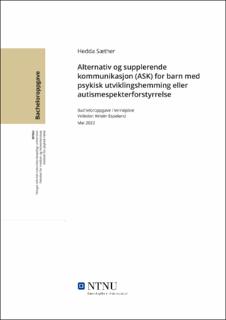| dc.description.abstract | Tittel: Alternativ og supplerende kommunikasjon (ASK) for barn med psykisk utviklingshemming eller autismespekterforstyrrelse.
Introduksjon/bakgrunn: På grunn av kognitiv funksjonssvikt vil barn med utviklingshemming og barn med autisme ha en forsinket eller avvikende språkutvikling sammenlignet med funksjonsfriske barn. For at disse barna skal kunne bruke språket sitt er det utviklet ulike kommunikasjonsformer, symbolsystemer og hjelpemidler, kjent under navnet ASK. ASK kan være et supplement til talen eller et alternativ til talen og skal gjøre det mulig for kommunikasjon og samhandling med andre mennesker.
Hensikt: Hensikten med oppgaven er å presentere at ulike former for ASK kan være nyttig og effektivt for språkutvikling hos barn med utviklingshemming eller autisme. Den skal også vise betydningen av vernepleierens rolle i arbeidet med disse barna.
Metode: I denne oppgaven blir det utført en litteraturstudie som inkluderer fem forskningsartikler hentet fra databaser. Annen relevant teori inngår også i oppgaven som støtte til forskningen.
Resultat: Resultatene fra de fem inkluderte forskningsartiklene viser at bruken av ASK kan hjelpe barn med utviklingshemming eller autisme til å utvikle seg språklig. Basert på hovedfunnene i artiklene er det trukket fram to temaer som diskuteres i oppgaven: 1. Formidlingsevne og 2. Interaksjon med andre.
Konklusjon: Forskning viser at både formidlingsevne og sosial interaksjon går lettere når barn med utviklingshemming eller autisme benytter ASK som hjelpemiddel. Implementering av ASK krever at det er gjort et godt forarbeid med kartlegging og at vernepleieren trer inn i rollen som en samhandlende partner. Datagrunnlaget fra artiklene tyder på at resultatene er generaliserbare, men det kan være nyttig med mer forskning for å gi et mer reliabelt svar på problemstillingen.
Nøkkelord: Alternativ og supplerende kommunikasjon, symbolsk kommunikasjon, språklig utvikling, utviklingshemming, autisme, barn.
Antall ord: 7078 | |
| dc.description.abstract | Title: Augmentative and alternative communication (AAC) to children with intellectual disability or autism spectrum disorder.
Introduction/background: Due to cognitive disabilities, children with intellectual disability and children with autism may have delayed or deviant linguistic development, compared to healthy children. To enable these children to make use of their language potential, certain language tools have been developed, which include alternative communication-forms, symbol-systems, and other aids. These tools, better known as AAC, may work as a supplement or alternative to speech and could enable children with cognitive disabilities to better communicate and interact with other people.
Purpose: The purpose of this assignment is to present different forms of AAC, and why they are useful and effective to improve linguistic development for children with intellectual disability or autism. It also aims to shed light on the importance of the disability nurses role in the work with these children.
Method: This assignment used a literature study as method. The literature study is based on five core research articles obtained from different research-databases, in addition to other relevant subject matter from literature, which substantiate the facts.
Results: Results shows that with the use of AAC as a tool, children with intellectual disability or autism indeed improve their linguistic development. Based on the findings in the research articles, two main headings were formed and were subject for further discussion in this assignment: 1. Communication skills and 2. Interactions with other people.
Conclusion: Research shows that both communication skills and social interactions improve when children with intellectual disability or autism, actively uses tools such as AAC. However, implementing of AAC’s require good mapping and preparations, as well as the disability nurses ability to play the role as an interactive partner. Data from the research articles suggest that results are generalizable, but there are still need of further research on the subject to ensure a reliable result.
Keywords: Augmentative and alternative communication, symbolic communication, linguistic development, intellectual disability, autism, children.
Number of words: 7078 | |
